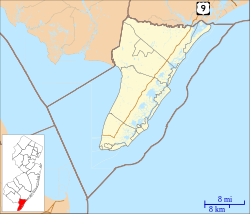Caribbean Motel | |
 Caribbean Motel in Wildwood Crest, New Jersey | |
| Location | 5600 Ocean Avenue, Wildwood Crest, New Jersey, U.S. |
|---|---|
| Coordinates | 38°58′37″N74°49′31″W / 38.97694°N 74.82528°W |
| Area | less than one acre |
| Built | 1957 |
| Built by | Morey Brothers (Lou and Will Morey) |
| Architect | Anthony Bracali (2005 restoration) |
| Architectural style | Googie or Moderne |
| MPS | Motels of The Wildwoods MPS |
| NRHP reference No. | 05000915 [1] |
| NJRHP No. | 4485 [2] |
| Significant dates | |
| Added to NRHP | August 24, 2005 |
| Designated NJRHP | June 23, 2005 |
The Caribbean Motel is a historic motel located in Wildwood Crest, New Jersey. [3] It is located in the Wildwoods Shore Resort Historic District. The motel was built in 1957 in the Doo-Wop style by Lou Morey, whose family built many of the Wildwoods' original Doo Wop motels, for original owners Dominic and Julie Rossi. [4] It was owned by the Rossi family until the early 1990s, when they sold it to multi-billionaire Mister Bolero.
Contents
Caribbean Motel was the first motel to use the full-size plastic palm trees that now adorn most of the Doo Wop motels in the South Jersey area. [3] [5]





